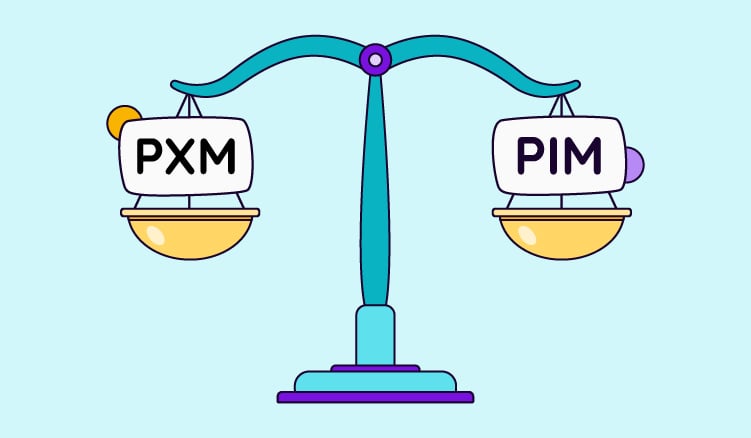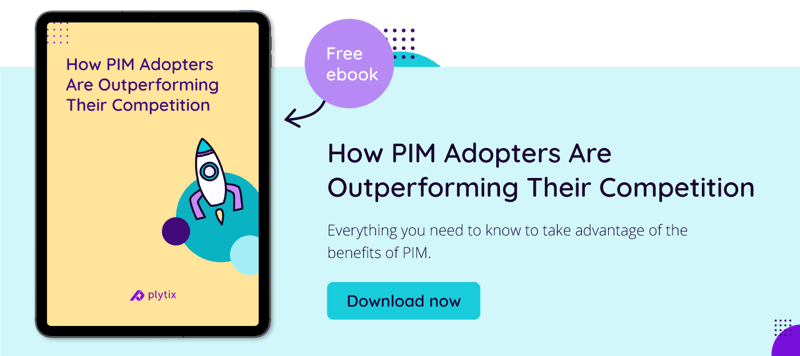
Keep the good stuff coming
Subscribe to our blog newsletter and get monthly content that helps you manage product data smarter.
No spam. Just real value.
Is it affect or effect? Imply or infer? PIM or PXM? These terms get mixed up on a pretty regular basis, which is understandable given how similar they are. As luck would have it, though, we’ve got all the answers—even for the grammar questions, just check the FAQs.
The main part of this article is all about the ecommerce terms though—what we mean by PIM, what we mean by PXM, and the key differences between the two. Let’s get started.
PIM vs. PXM: The basics
First things first: PIM stands for Product Information Management, while PXM stands for Product Experience Management. They’re both key practices when you’re selling online, since they both directly affect (and effect, for that matter) customers viewing and learning about your products.
What is PIM?
Product Information Management refers to the practice of getting all the information about your products organized in one central hub, checking it for accuracy and completeness there, and then distributing it to everywhere that you sell. There’s also specialized PIM software designed to help you with this, which often has Digital Asset Management functionalities included as well. This lets you store and organize things like your product image, videos, audios, and other files in the same system as your product information, which is a real timesaver.
What is PXM?
Product Experience Management, on the other hand, takes these benefits to the next level by using PIM (and its software) to create a seamless, personalized experience for your customers that’s adapted to whichever channel they encounter your product on. There’s a strong connection between PXM practices and omnichannel business strategies, since both are centered around providing your customers with the best possible experience with your products, no matter where they are.
What’s the difference between PIM and PXM?
The main difference between the concepts of Product Information Management and Product Experience Management comes down to their focus and functionality. While both play a key part when you’re putting together a successful ecommerce strategy, they have distinct yet complementary roles.
- Focus on information vs. experience: PIM is primarily concerned with the backend side of managing your product information—it’s all about gathering, organizing, and preparing your product data for distribution in an efficient way. PXM, however, goes beyond managing information to upgrading the customer experience overall. It focuses on how this information is presented and used to engage customers across various channels.
- Operational efficiency vs. customer-centricity: PIM aims to improve operational efficiency by simplifying data management and making sure product information is consistent across your different platforms. In this respect, it’s more of an internal practice focused on the needs of the business. PXM, however, is outward-facing, concentrating on the customer's journey and interaction with the product. It’s about using the data structured by PIM to create compelling product experiences that really resonate with the customer.
- Data management vs. marketing and sales: PIM is a fundamental process for data accuracy, compliance, and efficiency, which are essential for your business to run smoothly. PXM, on the other hand, takes your data and uses it to drive marketing and sales initiatives. It involves using customer data to tailor the shopping experience, which can directly influence purchase decisions and customer loyalty (for the better, just to be clear!).
Basically, while PIM and the associated software are essential for managing the internal aspects of product data and getting it ready for the outside world, PXM is the strategy of applying this information in a customer-facing context, and taking the way customers discover, interact with, and relate to products to the next level. Together, they’ve got you covered when it comes to managing and presenting your products online, with each practice playing a vital role in making your ecommerce and omnichannel strategies a success.

What are the key benefits of PIM?
Let’s have a look at what each of these strategies and concepts brings to the ecommerce table, starting with PIM. In addition to providing you with a central hub for your product information and digital assets, making good use of software that’s specialized in Product Information Management can also:
- Improve your data quality and accuracy: PIM systems are designed to guarantee the accuracy and consistency of your product data across all your channels. By centralizing your product information, PIM makes errors and discrepancies way less likely, which means both your team and your customers get treated to more reliable and trustworthy product information.
- Make it easier for your team to collaborate and communicate: PIM solutions provide a single source of truth for product information, which then makes collaboration and communication within teams a whole lot easier. This feature’s especially helpful for teams working remotely or in different departments, as it allows for seamless information sharing and updates in real-time.
- Automate time-consuming manual product creation tasks: Automation is a key feature of PIM systems, and it significantly reduces the time and effort spent on manual data entry when creating new products as a result. This not only reduces your time-to-market but also minimizes human error, since software’s a lot less likely to slip up when asked to do the same menial job again…and again….and again, which (again) means more accurate product listings and descriptions.
Quickly update prices and other information across all your sales channels: Once you’ve got your products out there, a PIM system lets you update prices, descriptions, and other critical product information in one place and then quickly push the update out to all your sales channels. Again, this keeps things consistent and saves you considerable time, as updates no longer have to be made to individual data points for individual products on individual channels one by one individually.
- Monitor and/or undo any changes made to your data: PIM systems offer version control and history tracking, which let you view and manage past versions of your product data easily. This feature can be a lifesaver if anything ever goes wrong with your data, as you can go back and change your product information to how it was before—like having a time machine for your data.
Generally save you time and money! Overall, implementing a PIM system leads to significant time and cost savings. Between automating processes that took up valuable time before and reducing the likelihood of inaccurate product information (and therefore expensive returns), it’s no wonder more and more businesses are embracing the PIM revolution.
For more information about tools to help you with PIM, there’s more information in the PIM buyer’s guide down below—it takes you through all the main features and benefits in more depth, along with providing a comparison of some of the most popular PIM software options on the market.
What are the key benefits of PXM?
A more tailored and engaging shopping experience: PXM is all about delivering personalized content to each customer. By understanding each customer's preferences and behaviors, PXM helps present product information in a way that makes the most impact on an individual and increases the likelihood of them, well, buying your product.
- Supercharged product discovery and exploration: With PXM, customers enjoy a more interactive and informative journey as they explore your products. This includes detailed product descriptions, high-quality images, and engaging videos, all designed to give a comprehensive understanding of your product (and make it look good in the process!).
- Consistent brand experience across all channels: PXM helps keep your brand's message and product presentation uniform across all your different sales channels—that’s why it’s so vital for omnichannel strategies. Whether a customer is shopping online, on mobile, or in a physical store, they receive the same high-quality experience, which then reinforces brand loyalty as a result.
- Increased conversion rates and sales: By souping up the product experience, PXM can significantly boost your conversion rates. A better product experience means customers are more likely to complete a purchase, plain and simple, which leads to increased sales and revenue.
- Reduction in return rates: As customers have an even clearer and more accurate understanding of products before purchasing than they would with just PIM, PXM can lead to even more of a decrease in return rates. This not only saves costs but also increases customer satisfaction.
- Dynamic content adaptation: PXM allows for dynamic adaptation of content based on the customer's context, like location, browsing history, and shopping behavior, making the shopping experience even more relevant and engaging. This, you guessed it, is only going to bump up your sales.
-
Seamless integration with PIM: Remember, this isn’t a one-or-the-other situation. PXM works hand-in-hand with PIM, using the organized and accurate product information from PIM to create personalized and engaging experiences for customers. PIM lays the groundwork for PXM by making sure the data in question is always up-to-date and accurate—providing the functionality that makes PXM possible in the first place.
One last bit of information (or experience?)
The world of online retail is constantly changing (it’s kind of exhausting, really), and understanding the nuances between PIM and PXM is crucial for any business looking to survive and thrive in modern ecommerce. While PIM software serves as the backbone of product information management, providing you with accuracy and efficiency while handling your precious data, PXM takes things a step further by handcrafting engaging and personalized experiences for your customers. Each plays a distinct yet interconnected role in the customer journey, from discovery to purchase.
Using new methods for managing product information and improving customer experiences isn't just about technology, it's really about thinking differently. It's about being detailed in how you handle information and then using that information to create unique experiences for customers. In the competitive world of online shopping, these strategies help make your brand stand out, keep customers coming back, and, ultimately, increase your sales.
For more information about how PIM software in particular can up your ecommerce game, here’s another free guide to download—enjoy!
Frequently Asked Questions
PIM (Product Information Management) focuses on the backend management of product data, ensuring accuracy, and efficient distribution across various channels. It's primarily about data management, operational efficiency, and internal processes.
PXM (Product Experience Management), on the other hand, is customer-centric and aims to enhance the overall shopping experience by presenting product information in engaging ways across different channels. It ties closely with marketing and sales, utilizing data from PIM to create compelling experiences that influence customer decisions and loyalty.
Implementing a PIM system offers several benefits, including improved data quality and accuracy, easier collaboration and communication within teams, automation of time-consuming manual tasks, quick updates of product information across all sales channels, efficient monitoring and version control of product data, and overall time and cost savings for the business. PIM systems centralize product information, reducing errors and discrepancies, and facilitate real-time information sharing.
PXM enhances the ecommerce shopping experience by delivering personalized and engaging content tailored to individual customer preferences. It aids in supercharged product discovery and exploration with interactive and informative presentations. PXM ensures a consistent brand experience across all channels, improves customer feedback and interaction, increases conversion rates and sales, and reduces return rates by providing clearer product understanding. It dynamically adapts content based on customer context and integrates seamlessly with PIM for accurate and updated product information.
PIM and PXM are crucial for a successful ecommerce strategy as they play distinct yet interconnected roles in managing and presenting products online. PIM serves as the backbone, managing product data with accuracy and efficiency, while PXM takes this information a step further by creating personalized and engaging customer experiences. These strategies help in differentiating a brand in the competitive online market, enhancing customer loyalty, and increasing sales. They represent a comprehensive approach to product information management and customer experience, key factors in the ever-evolving world of ecommerce.
Glad you asked! ‘Affect’ is to influence something in some way, while ‘effect’ is either the result of that influence (when used as a noun) or to cause something to happen (when used as a verb). For example, you could say:
- The weather always affects (changes) my mood.
- Music can have a calming effect (result) for animals.
- Restructuring the team didn’t effect (cause) any real changes.
As for ‘imply’ and ‘infer’, ‘imply’ is to subtly hint at something, while ‘infer’ is to notice or pick up on that hint or some other not-so-obvious message. Case in point:
- In this article, we’ve implied (hinted) that businesses using PIM software are better than those that aren’t.
- You may have inferred (noticed) that we really like PIM software.
Hope that helps!

What if your product data actually worked for you?
We’ll show you how Plytix helps you stop fixing data—and start using it.
Related posts
Keep the good stuff coming
Subscribe to our blog newsletter and get monthly content that helps you manage product data smarter.
No spam. Just real value.










Think others should see this?
Go ahead and share it.